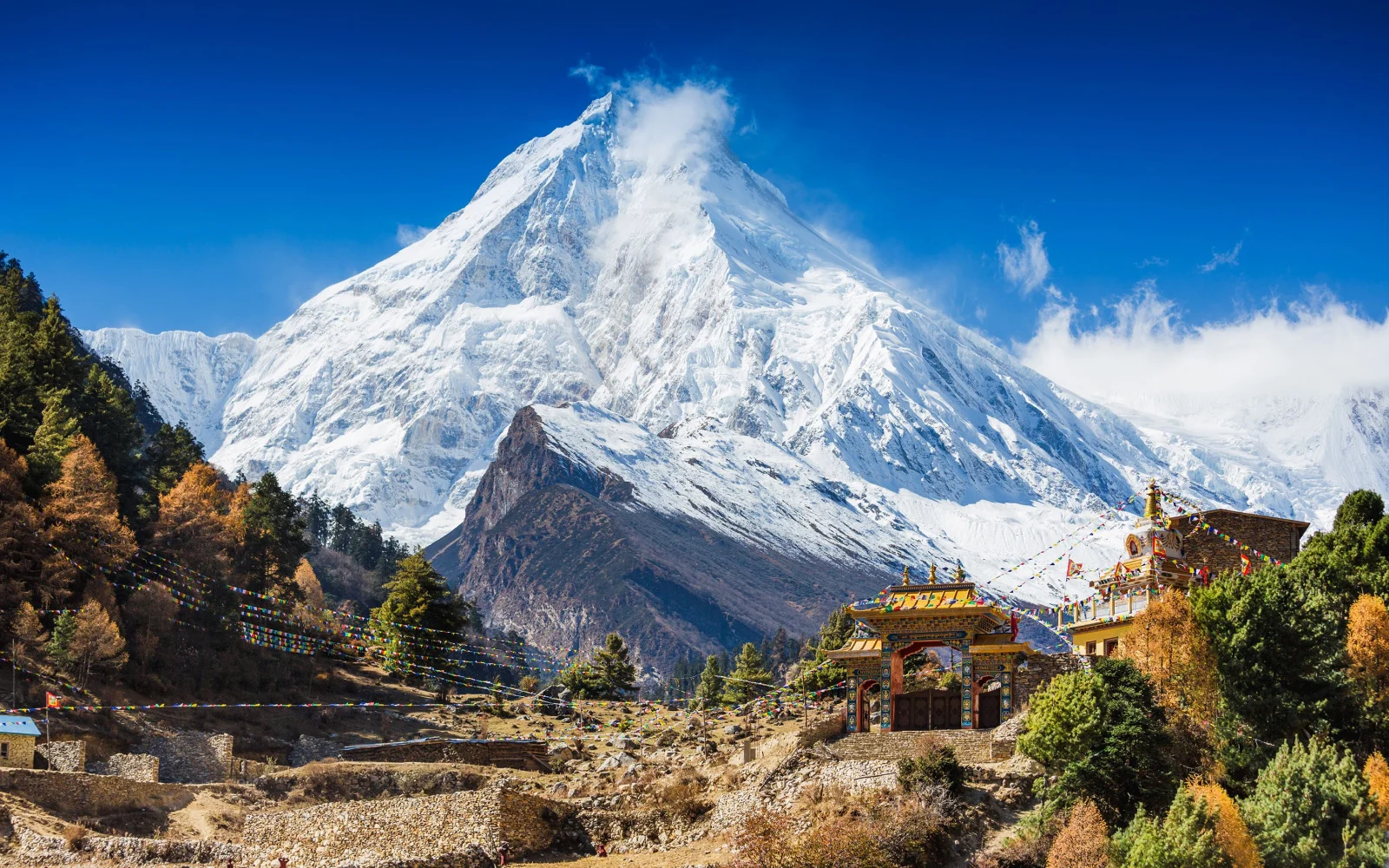What's the best time to visit Nepal?
The best time to visit Nepal is between October and February. The weather is perfect for hiking, climbing, and festivals. This period features dry conditions, mild temperatures, and minimal rainfall, ideal for outdoor adventures and wildlife safaris.
Although it’s a peak season with slightly higher hotel prices, the opportunity to experience the Himalayas and vibrant local festivals like Dashain and Tihar makes it worthwhile. Late January and February are especially great for wildlife viewing, with clear views and accessible national parks.
Adventurers, nature lovers, and cultural explorers will find Nepal one of the most fascinating places to travel in the world. This mountainous, jungled, and spiritual destination is even better when you know the best time to visit Nepal.
Whether you’re planning to summit Everest, explore traditional villages carved into the mountainsides, or wander through the jungle on safari, there are certain times of year that offer excellent conditions for exploring the country.
We’ll show you a few reasons to visit and the best to visit Nepal along with the cheapest, and least busy times to go. Let’s dive in!
The Overall Best Time to Visit Nepal
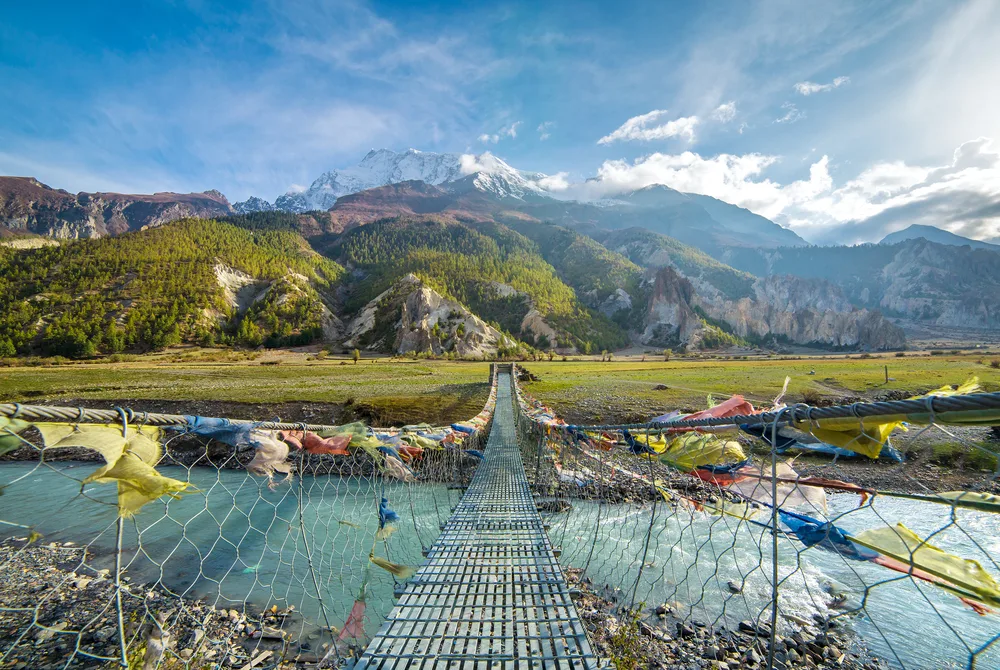
Mazur Travel/Shutterstock
The best time to visit Nepal is October through February. These months offer dry conditions, warm weather with lower humidity, and excellent opportunities to hike, climb, go on safari, and explore Nepal.
Clear skies make a visit to Nepal so much more enjoyable, and with cooler conditions between October and February (a good portion of the dry season), you might only see 0.1″ to 1.8″ of rain this time of year throughout the country.
Temperatures hover between comfortable highs from 65F to 89F this time of year (generally on the warmer end in October and November), though highs can hit the mid-90s in the southeast near the border with India and overnight lows can drop to the 50s, 40s, and upper 30s in high altitudes.
This peak period brings lots of tourists to Nepal. You can expect slightly higher hotel prices during some of these months (2-5 star hotels):
- October: $48-$646/night
- November: $28-$496/night
- December: $26-$519/night
- January: $26-$642/night
- February: $14-$135/night
If you’re coming to Nepal to hike in the Himalayas, attempt to summit Everest, go on safari in the jungles, or explore the charming mountain villages, October through February is the prime time to visit.
You’ll find the best prospects for wildlife viewing (especially big game, like tigers and elephants) is between late January and February. Locals hack the tall elephant grass in January and that makes it much easier to spot wildlife lurking in the leafy jungles of Chitwan and Bardiya National Park.
The dry, mild conditions are also ideal for hiking, mountaineering, and climbing in the Himalayas, especially in October and November (the peak climbing season). You’ll avoid the hottest and most humid weather that arrives around March and avoid the torrential monsoon season that begins in June and continues through August.
Visiting in late fall or winter means you’ll get to enjoy some of Nepal’s most popular festivals, holidays, and events:
- Dashain (September/October) is one of the biggest Nepalese festivals, lasts 15 days, and includes colorful decorations in the streets with parades, animal sacrifices, red powder applications, and amazing kite displays.
- Tihar (October/November) is called the Festival of Lights and lasts 5 days as locals worship nature and animals (cows, dogs, crows, farmland, etc.) with a special Bhai Tika ritual involving colorful flower garlands and lots of candles and oil lamps to create a lovely glow.
- Udhauli (November/December) is a harvest festival thrown by the Limbu people marked with traditional dancing, singing, dress, and sacrificial offerings to deities and ancestors.
- Sweta Manchhendra Snan (January) is a 1-week festival at the Kathmandu temple by the same name where the goddess Kumari is said to visit and watch the music, offerings, and rituals to decide whether to deliver ample rain in the coming summer season.
- Swasthani Puja (Janaury/February) celebrates the goddess Swasthani with locals reading her scripture every night during the months of January and February in hopes of bringing communities together, gifting people with blessings, and removing curses.
- Maghe Sankranti (January) marks the holy month as locals feast, bathe in the rivers, make their way to deity shrines and temples to worship, and present food, flower, and incense offerings as they read the Song of the Gods and oil their bodies.
- Basanta Panchmi & Saraswati Puja (January) sees people crowd into Durbar Square in Kathmandu to greet the King with live music, dancing, and offerings related to the upcoming springtime and the start of a new season of growth.
- Losar (February) is when the Tibet and Sherpa people officially welcome the new year with traditional dancing, costumes, songs, and gifts of jewelry and clothing. Monasteries and temples are decorated with prayer flags and people throw roasted barley flour in the air like confetti.
Overall, any month between October and February will be great for a visit to Nepal, but many people see October and February as the absolute best months to go.
Cheapest Time to Visit Nepal
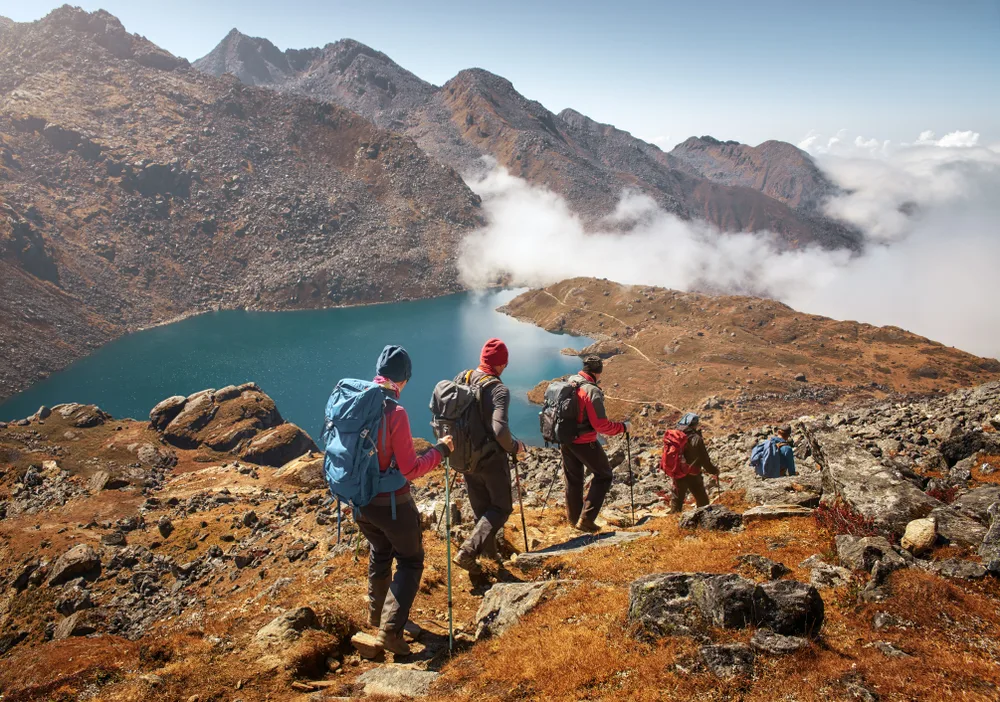
soft_light/Shutterstock
The cheapest time to visit Nepal is February through April. While it’s a busy season for tourism, prices on hotels and accommodations drop as they compete to attract travelers at the end of the peak season.
This is an excellent time of year to visit Nepal if you want to enjoy the weather while it’s dry and spend less on your accommodations, tour tickets, and daily expenses.
You’ll appreciate the mild weather between February and April across much of Nepal, though it’s hot and humid in some areas. Highs range from a comfortable 69F in Kathmandu to a scorching 101F in Biratnagar in April. Rainfall is minimal with no region seeing more than 1.3″ of rain in a 30-day period this time of year.
The average nightly rate drops all the way to $14-$16/night for budget 2-star hotels and hovers around $135-$144/night for luxury 5-star hotels and mountain lodges. Here’s a look at what you can expect to pay nightly between February and April:
- February: $14-$135/night
- March: $15-$142/night
- April: $16-$144/night
While it can be a real test of your fortitude to head into the hot, steamy jungles this time of year, you’ll be rewarded with excellent wildlife viewing opportunities as the elephant grass is shorter and it’s easier to see big cats, elephants, rhinos, and birds. With so little rain, you won’t have to worry about mud or impassable trails.
This is one of the peak times for mountain climbing, too. The months of March and April are especially nice for treks up into the Himalayas. This is one of the reasons Nepal is so popular to visit this time of year (besides the cheaper prices).
Near Everest region are the high-altitude, holy Gokyo Lakes in a gorgeous valley you shouldn’t skip!
There are several religious festivals and cultural events that take place between February and April:
- Maha Shivaratri (February) is when people crowd the Pashputi Temple in Kathmandu to worship Lord Shiva so tightly that it’s said there’s not enough room for a sesame seed left. Ash is rubbed on bodies, people pray to Shiva and hear lectures, bonfires and feasts happen, and people join in music and dance together in the streets.
- Holi or Fagu Purnima (March) sees Nepalese people decorate a chit pole with colorful prayer flags on Durbar Square in Kathmandu and don old, worn out clothes because colored powders and water balloons will fill the streets this week and no one can avoid being splashed or doused in red powder!
- Chaitra Dasain (March-April) is another colorful festival, this one celebrates Ram and his victory over an evil king with help from the Mother Goddess Durga with offerings, sacrifices, and red vermillion powder dousing in the streets.
- Ghode Jatra (April) celebrates the defeat and burial of a demon centuries ago with a parade of horses over the supposed burial spot, which locals believe will prevent the demon from rising again. Dancing, singing, and gymnastics performances are how locals celebrate the victory.
While the cheapest time of year to visit is very busy with tourists (except April), you’ll save a considerable amount on your hotel and have opportunities to enjoy the natural beauty and culture of Nepal during this time.
Least Busy Time to Visit Nepal
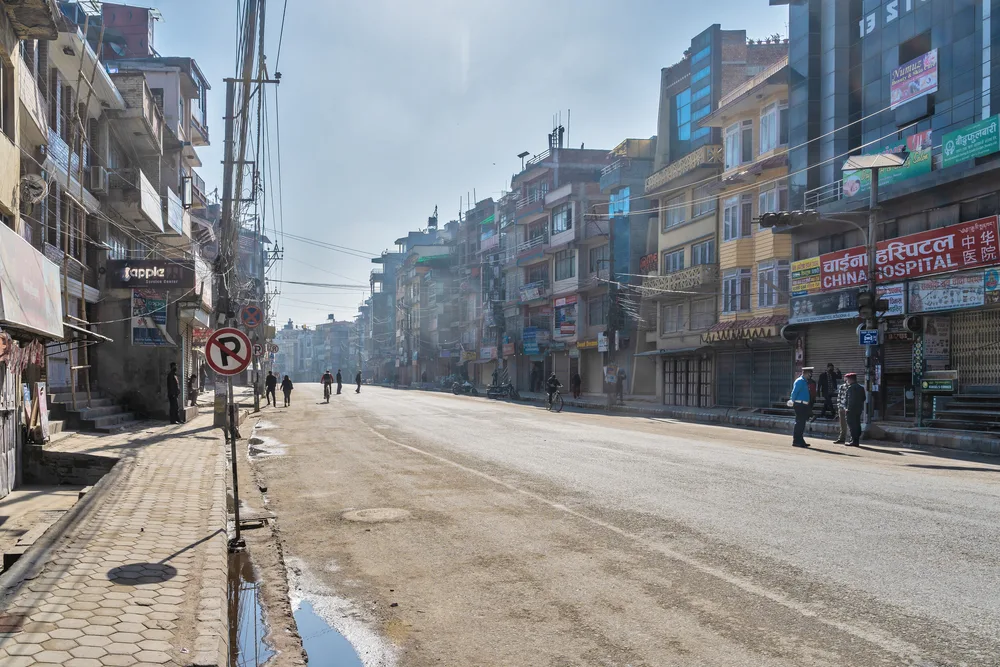
March 25, 2020. Kathmandu, Nepal. The Bouda area. Against the background of an empty deserted street and quarantined shops, a only policeman and lonely pedestians far away/Denis Dymov/Shutterstock
The least busy time to visit Nepal is during the months of April and May, just ahead of the looming monsoon season.
April and May are the two slowest months of the year for tourism in Nepal, making them ideal months to visit if you’re hoping to sidestep the biggest crowds and enjoy Nepal’s scenery and towns with fewer people around.
You’ll appreciate low prices on hotels, wide-open availability for hotels and flights, and more affordable tours and attractions this time of year.
If you come in April or May, you’ll be rewarded with some of the most incredible weather and conditions for hiking, mountain climbing, and wildlife viewing in the jungle regions.
The weather isn’t quite as prime as it is earlier in the year, getting warm, hot, or downright miserable in some areas of Nepal by the time April and May roll around. Expect daily highs from 81F to 101F this time of year with oppressive humidity around the country.
Hotel rates reflect the massive dip in tourism in April and May, dropping as demand dwindles ahead of the summer monsoon season:
- April: $16-$144/night
- May: $18-$160/night
The soaring temperatures and humidity can make venturing into Nepal’s jungles and national parks a lot more challenging.
However, there’s no better time of year to spot some of the most iconic wildlife wandering through the leafy underbrush and gathering along the rivers. Adventure tourism is nice this time of year with shorter lines and smaller groups on guided hikes and climbs.
Worst Time to Visit Nepal
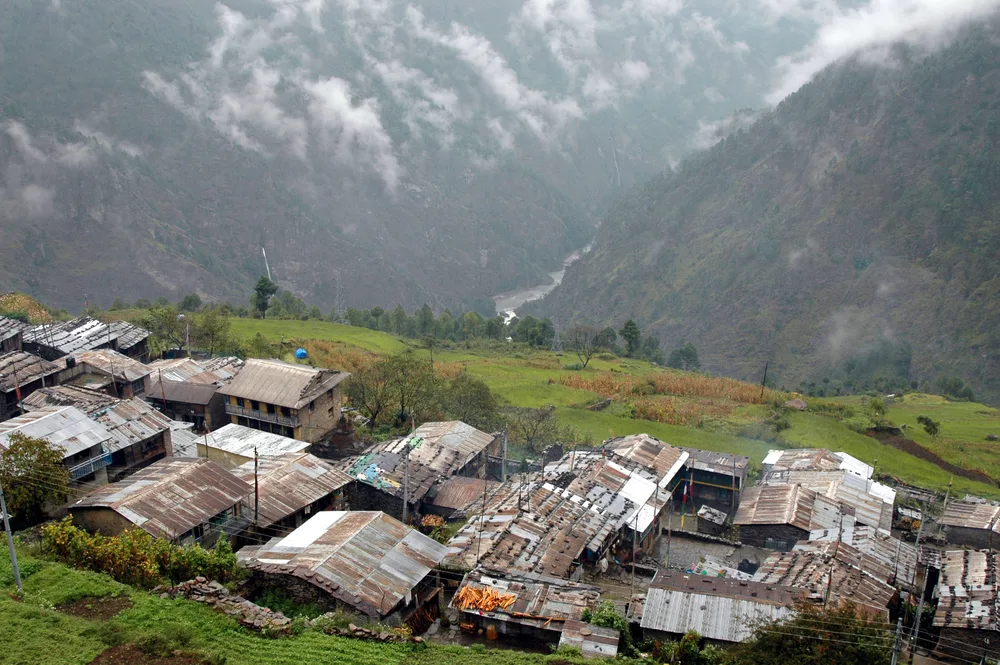
Georgian Bay Boudoir/Shutterstock
The worst time to visit Nepal is during its monsoon season, from June to August, as it brings heavy rains, high winds, and incredibly muggy conditions.
The summer monsoon season in Nepal is far from hospitable for outdoor adventures and recreation. The jungles are steamy, wildlife is harder to view with tall grasses offering camouflage, and many areas of the national parks are inaccessible due to heavy rains.
Even mountaineering is difficult during the monsoon season with torrential downpours, high winds, and the possibility of dangerous landslides making the trek more challenging. Many mountain passes are closed this time of year to help climbers avoid these risks.
The wet weather brings hordes of mosquitoes to Nepal, increasing the risk of mosquito-borne disease including dengue fever and malaria. The risk of contracting cholera, transmitted by tiny crustaceans in freshwater, also rises during the monsoon season.
The only real upside to visiting during the summer monsoon season is the drop in hotel prices this time of year:
- June: $18-$158/night
- July: $19-$158/night
- August: $20-$156/night
Still, you can find even cheaper nightly rates during the milder, drier, and busier season between February and April without the rain, heat, and humidity of summer.
Nepal by Month: Climate & Activities
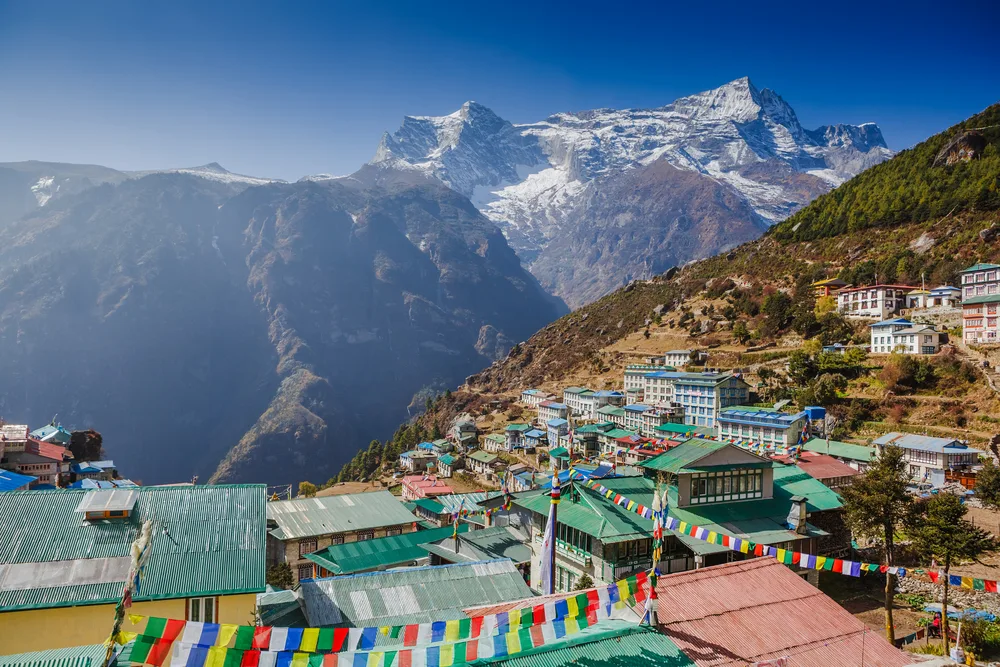
Olga Danylenko/Shutterstock
Still unsure about the best time to visit Nepal? Take a look at our summary of the weather and climate by month below:
January
January in Nepal, with temperatures often ranging from 36 to 66°F (2 to 19°C) in the Kathmandu Valley, is a great time for clear mountain views, exploring cultural sites in Kathmandu, and witnessing the Maghe Sankranti festival, marking the end of winter.
February
February continues with cool weather, ideal for visiting the historic city of Bhaktapur, enjoying short treks in the lower Himalayas, and experiencing the serenity of the monasteries in the Kathmandu Valley.
March
As spring begins, March brings temperatures from 45 to 70°F (7 to 21°C). This is a great time for trekking in regions like the Annapurna Circuit or Everest Base Camp, exploring the wildlife in Chitwan National Park, and celebrating the colorful festival of Holi.
April
April’s mild weather, with temperatures between 55 to 77°F (13 to 25°C), beckons for exploring the Patan Durbar Square, enjoying the rhododendron blooms in the hills, and visiting the peaceful Pokhara city by the Phewa Lake.
May
May brings warmer days, from 64 to 82°F (18 to 28°C), perfect for trekking in the Langtang region, experiencing the Buddha Jayanti festival in Lumbini, the birthplace of Buddha, and exploring the medieval Newari towns around the Kathmandu Valley.
June
June, ushering in the monsoon with temperatures between 68 to 84°F (20 to 29°C), offers lush green landscapes, ideal for cultural tours in Kathmandu and Pokhara, and visiting the ancient city of Patan.
July
July’s monsoon season, ranging from 70 to 82°F (21 to 28°C), invites you to experience the vibrant festivals like Ropain, the rice planting festival, explore the local museums, and enjoy the indoor attractions of Kathmandu.
August
In August, with temperatures of 70 to 82°F (21 to 28°C), visit the World Peace Pagoda in Pokhara, explore the art and architecture of the Kathmandu Durbar Square, and witness the Gai Jatra and Krishna Janmashtami festivals.
September
Welcoming fall, September, with temperatures from 66 to 79°F (19 to 26°C), is perfect for trekking as the monsoon recedes, offering clear skies and excellent mountain views, and attending the Indra Jatra festival in Kathmandu.
October
October’s cooler days, from 58 to 77°F (14 to 25°C), are ideal for the Dashain festival, Nepal’s biggest Hindu celebration, trekking in the Everest and Annapurna regions, and visiting the Boudhanath Stupa for spiritual experiences.
November
November, as the air turns crisp, temperatures from 48 to 72°F (9 to 22°C), is a time for the Tihar festival, trekking in the comfortable climate, and exploring the cultural heritage of the Kathmandu Valley.
December
December brings cooler weather, from 36 to 66°F (2 to 19°C), along with clear skies for mountain views. Enjoy visiting the ancient temples and palaces in Kathmandu, exploring the medieval cities of Bhaktapur and Patan, and experiencing the unique Newari culture.
Frequently Asked Questions
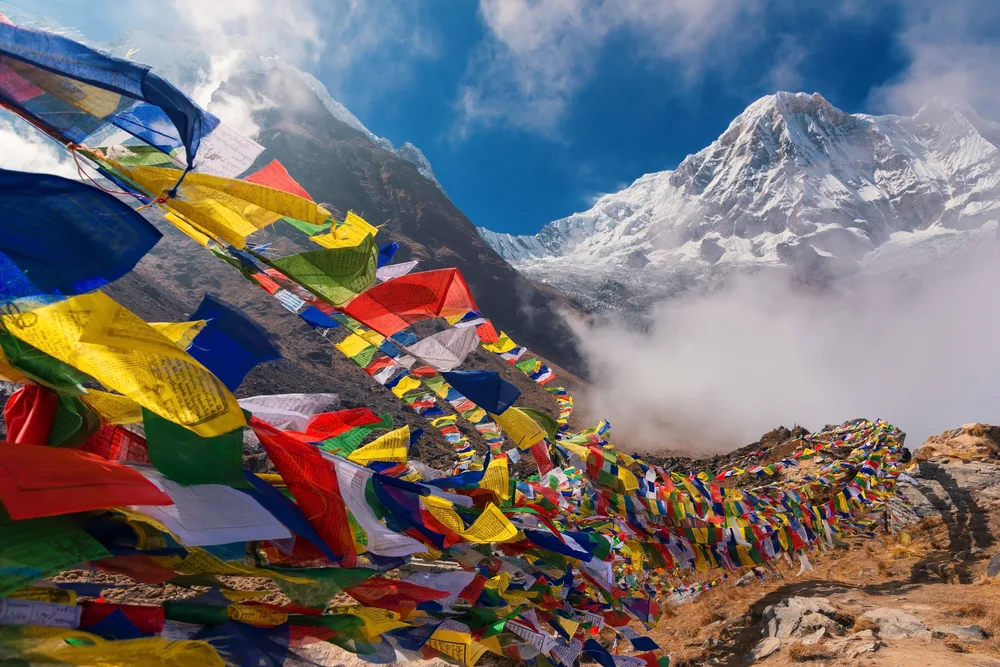
Pisit Rapitpunt/Shutterstock
Learning the best time to visit Nepal is the first step to planning your visit, but you’ll have an easier time when you have the answers to travelers’ most frequently asked questions!
Which is the best month to visit Nepal?
The best month to visit Nepal is the month of February. This is a month of overlap where you can experience prime, mild weather, excellent wildlife viewing opportunities in the jungles, great conditions for mountaineering, and tons of cultural festivals and holidays.
The entire periods from October to February and February to April are ideal for great weather, with the latter period bringing lower prices and slightly hotter temperatures.
What is the best time of year to go to Kathmandu?
The best time of year to go to Kathmandu is during the fall and winter, between September and February. You'll find ideal temperatures in the 60s and 70s, very little rainfall, and lots of religious festivals and holidays taking place.
Conditions are perfect in the fall and winter for climbing, hiking, visiting the high-altitude lakes, going on safari, and touring the mountain villages in Nepal.
Which months are very wet in Nepal?
The wettest months in Nepal are June, July, and August, which make up the summer monsoon season. As the wettest months of the year, June-August see anywhere from 4.3" to 10.5" of rain in each 30-day period. Temperatures and humidity levels rise considerably during the monsoon season, bringing highs from 82F-93F with muggy conditions near 100% humidity each day.
So, What’s the Best Time to Visit Nepal?
The best time to visit Nepal is October through February for dry, warm, and low-humidity conditions that are prime for hiking, mountaineering, exploring villages, and venturing into the jungles on safari. For budget-minded travelers, February to April, though a little hotter and more humid, is ideal with cheaper hotels.
The least busy time to visit Nepal is April and May when tourism drops just before the heavy monsoon season hits in the summertime. It’s a peaceful time to be in the mountains, jungles, or historic sites of Nepal.
If you can, avoid visiting during June, July, or August in the summer monsoon season. You’ll face high winds, heavy rainfall, and oppressive humidity that makes it harder to enjoy Nepal’s many treasures.
With these travel guidelines in mind, you’ll be able to plan your trip to Nepal to optimize your sightseeing and adventures in this stunning country.



